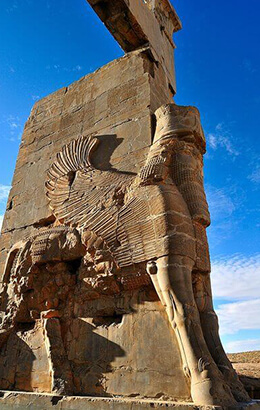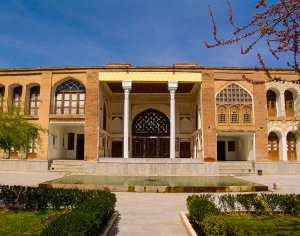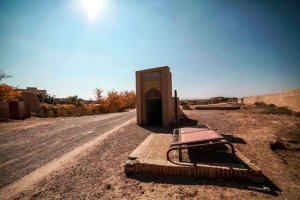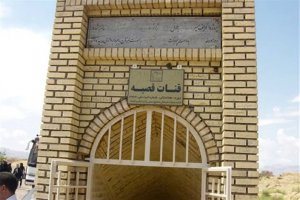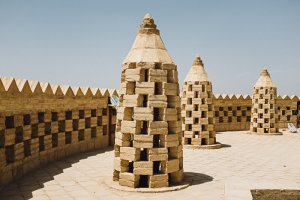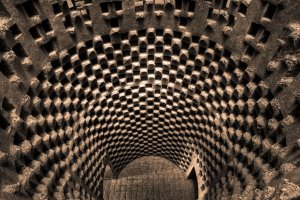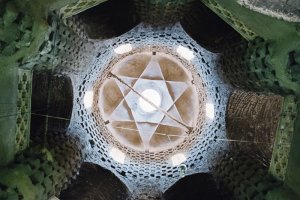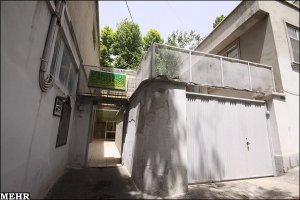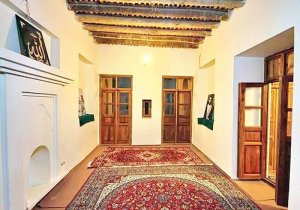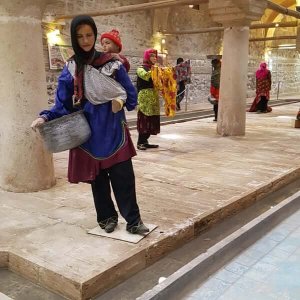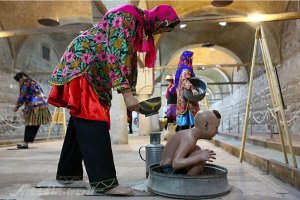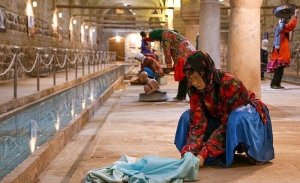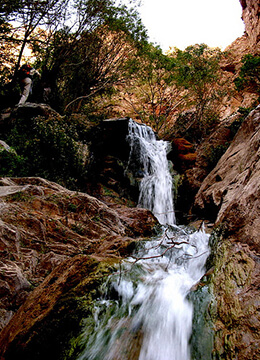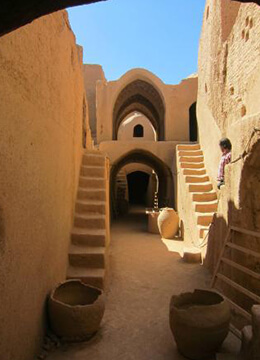Iran’s Popular Attractions
Historical Sites
PART 1
Tchogha Zanbil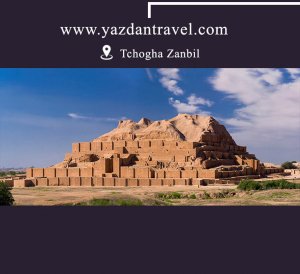
The ruins of the holy city of the Kingdom of Elam, surrounded by three huge concentric walls, are found at Tchogha Zanbil. Founded c. 1250 B.C., the city remained unfinished after it was invaded by Ashurbanipal, as shown by the thousands of unused bricks left at the site. Located in ancient Elam, today Khuzestan province in southwest Iran, Tchogha Zanbil, Dur-Untash, or City of Untash, in Elamite, was founded by the Elamite king Untash-Napirisha, 1275-1240 BC, as the religious center of Elam. The principal element of this complex is an enormous ziggurat dedicated to the Elamite divinities Inshushinak and Napirisha. It is the largest ziggurat outside of Mesopotamia and the best preserved of this type of stepped pyramidal monument. The archaeological site of Tchogha Zanbil is an exceptional expression of the culture, beliefs, and ritual traditions of one of the oldest indigenous people of Iran. Our knowledge of the architectural development of the middle Elamite period, 1400-1100 BC, comes from the ruins of Tchogha Zanbil and of the capital city of Susa 38 km to the north-west of the temple.
Soltaniyeh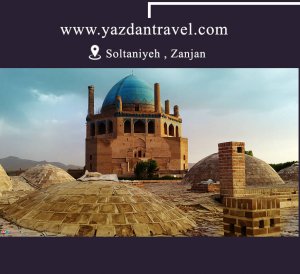
The mausoleum of Oljaytu was constructed in 1302–12 in the city of Soltaniyeh, the capital of the Ilkhanid dynasty, which was founded by the Mongols. Situated in the province of Zanjan, Soltaniyeh is one of the outstanding examples of the achievements of Persian architecture and a key monument in the development of its Islamic architecture. The octagonal building is crowned with a 50 m tall dome covered in turquoise-blue faience and surrounded by eight slender minarets. It is the earliest existing example of the double-shelled dome in Iran. The mausoleum’s interior decoration is also outstanding and scholars such as A.U. Pope have described the building as ‘anticipating the Taj Mahal’.
Pasargadae
Pasargadae was the first dynastic capital of the Achaemenid Empire, founded by Cyrus the Great, in Pars, homeland of the Persians, in the 6th century BC. Its palaces, gardens and the mausoleum of Cyrus are outstanding examples of the first phase of royal Achaemenid art and architecture and exceptional testimonies of Persian civilization. Particularly noteworthy vestiges in the 160 sites include: The Mausoleum of Cyrus II; Tall-E-Takht, a fortified terrace; and a royal ensemble of gatehouse, audience hall, residential palace and gardens. Pasargadae was the capital of the first great multicultural empire in Western Asia. Spanning the Eastern Mediterranean and Egypt to the Hindus River, it is considered to be the first empire that respected the cultural diversity of its different peoples. This was reflected in Achaemenid architecture, a synthetic representation of different cultures.
Persepolis
Founded by Darius I in 518 B.C., Persepolis was the capital of the Achaemenid Empire. It was built on an immense half-artificial, half-natural terrace, where the king of kings created an impressive palace complex inspired by Mesopotamian models. The importance and quality of the monumental ruins make it a unique archaeological site.
Meidan Emam, Isfahan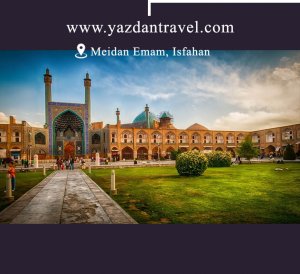
Built by Shah Abbas I the Great at the beginning of the 17th century, and bordered on all sides by monumental buildings linked by a series of two-storied arcades, the site is known for the Royal Mosque, the Mosque of Sheikh Lotfollah, the magnificent Portico of Qaysariyyeh and the 15th-century Timurid palace. They are an impressive testimony to the level of social and cultural life in Persia during the Safavid era.
Tabriz Historic Bazaar Complex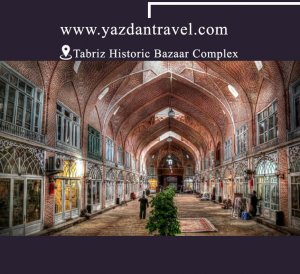
Tabriz has been a place of cultural exchange since antiquity and its historic bazaar complex is one of the most important commercial centers on the Silk Road. Tabriz Historic Bazaar Complex consists of a series of interconnected, covered, brick structures, buildings, and enclosed spaces for different functions. Tabriz and its Bazaar were already prosperous and famous in the 13th century, when the town, in the province of Eastern Azerbaijan, became the capital city of the Safavid kingdom.
Susa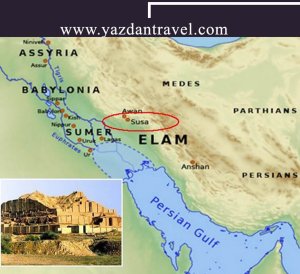
Located in the south-west of Iran, in the lower Zagros Mountains, the property encompasses a group of archaeological mounds rising on the eastern side of the Shavur River, as well as Ardeshir’s palace, on the opposite bank of the river. The excavated architectural monuments include administrative, residential and palatial structures. Susa contains several layers of superimposed urban settlements in a continuous succession from the late 5th millennium BC until the 13th century CE. The site bears exceptional testimony to the Elamite, Persian and Parthian cultural traditions, which have largely disappeared.
Gonbad-E-Qābus, Qabus Dome
The 53 m high tomb built in 1006 AD for Qābus Ibn Voshmgir, Ziyarid ruler, near the ruins of the ancient city of Jorjan, today Gorgan, in north-east Iran, bears testimony to the cultural exchange between Central Asian nomads and the ancient civilization of Iran. The tower is the only remaining evidence of Jorjan, a former center of arts and science that was destroyed during the Mongols’ invasion in the 14th and 15th centuries. It is an outstanding and technologically innovative example of Islamic architecture that influenced sacral building in Iran, Anatolia and Central Asia. Built of unglazed fired bricks, the monument’s intricate geometric forms constitute a tapering cylinder with a diameter of 17–15.5 m, topped by a conical brick roof.
Tabas Golshan Garden
Golshan Garden is one of the most famous and historic gardens of Iran related to Zand and Qajar Period located in Tabas in South Khorasan Province. It has been constructed by Mir Hasan Khan, the third ruler appointed by Nader Shah Afshar to administer Tabas and Tun cities of Khorasan, in the late government of Zand prince, Lotf Ali Khan.
Monastery of Saint Thaddeus or Qara Kelisa
Monastery of Saint Thaddeus or Qara Kelisa in Bah Bah Jik County, 20km of Chaldoran City, is located in the highest part of the West Azerbaijan Province in the south part if Maku Town. Qara means black and choosing the name Qara Kelisa for this building indicates the usage of black stone in some parts of its facade.
 Babak Castle
Babak Castle
Babak Castle is a large citadel on the top of a mountain in the Arasbaran forests, 6 km southwest of Kalibar City in northwestern Iran. It was the stronghold of Babak Khorramdin, the leader of the Khurramites in Iranian Azerbaijan who fought the Islamic caliphate of Abbassids.
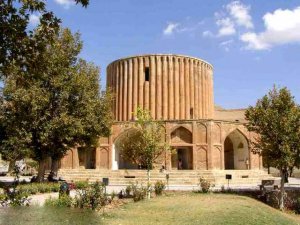 Kalat Palace
Kalat Palace
Kalat Palace known as the Sun Palace, one of the most beautiful unfinished tower tomb, primarily was a mausoleum related to the Ilkhanid dynasty; the current building of this palace has been constructed on the remains of the old building in Afsharid era. The Sun Palace was the resident place and a place to keep the jewels and the spoils of war as the result of Nader Shah Afshar conquests now some parts of it has been turned into a museum.
Asef Edifice, Kordish House
Asef Edifice named “Kurdish house” as a symbol of Kurds tribe’s cultural identity is the most valuable cultural relics of Sanandaj. The original building of edifice construction contains the most parts of northern side which includes the ceremonial hall, rooms and corridors parties and some parts of the eastern spaces related to Safavid era and the other parts or components have been added in Qajar and Pahlavi periods. Motamed Hashemiha’s family is known as the first founder of this building and probably Mirza Mohammad Reza Vaziri, Asef Divan’s father, has owned it and this edifice gained its final magnificence by constructing the entrance with a brick facade on the Iranian Baroque style and eastern and western parts of it during Asef Divan period.
Ghasabeh
Ghasabeh aqueduct is the biggest, deepest, the most admired and the oldest world’s aqueduct related to 2500 to 2700 years ago, one of the world’s hydro system masterpiece constituted of two major canals and six secondary branches. The number of wells in this aqueduct is more than 470 and its major well is located on the north hillside of Siahkuh in the depth of 280 to 300 meters.
Nashtifan Asbad or windmills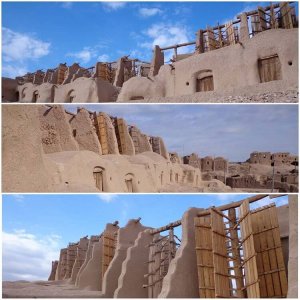
Nashtifan Asbad or windmills in Khaf is one of the biggest adobe, mud and wooden complex from Safavid era and also the biggest and the oldest world’s Asbad complex. Most of historians determine its genesis before the Muslim conquest of Iran and the others recognize it about 1700 years before Christ birth.
Haft Tanan garden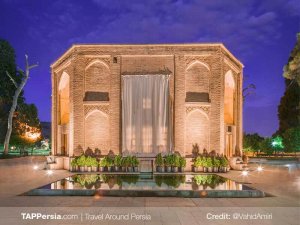
Haft Tanan garden is one of the oldest historical sites of Shiraz. This garden dating back to centuries before Zand era and its building relates to Karim Khan Zand era, is located near to the Chehel Maqam Mountain in the north of Hafez mausoleum. People went to this location to ask for rain or worship in the past. This garden named Haft tanan due to the presence of the graves of seven wise persons there on which Karim Khan Zand had installed large stones without inscription.
Kamal-ol-Molk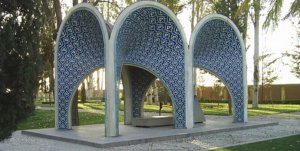
The building is the burial place of one of the most famous historical character of contemporary art of Iran, Mohammad Ghaffari known as Kamal-ol-Molk, the Iranian painter, Kashan 1224- Neyshabur 1319 that is located in the vicinity of Attar tomb, the Iranian famous poet and mystic, in the Attar garden. Kamal-ol-Molk mausoleum is designed by Houshang Seyhun with a harmonious combination of traditional and modern architecture in which, geometry, has a basic role and deeply connected to the Iranian architectural system.
Arg-E-Kolah Farangi
Arg-E-Kolah Farangi is a historical monument of Birjand that is now the place of governorship in South Khorasan Province. Attributed to Amir Hassan Khan Sheibani, the building once belonged to Amir Alam, who donated it to the governor of Birjand. This building belongs to the late Zand and the early Qajar eras.
Yakhdan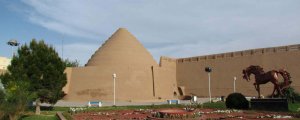
The Yakhdan has been used to keep the ice in the summer of the past years. Probably, the owner of this yakhdan (ice-house) was a man called Moayedodin Reyhan who was one of the Kerman state officials. This building has been built in the late of Safavid dynasty and this yakhdan called Moayedi because the Moayedi subterranean supplied the water of it.
Mil Ejdeha
Mil Ejdeha or fire temple related to Parthian period is located in a valley along the Tang-E-Koleh Mountain on the rocky and lush hillside, next to one of the ancient important ways. There is no village in this area. This square stone tower which seems to be a fire temple or temple is a square like the Zoroaster Kaaba or Pasargadae prison tower. The height of the tower is more than seven meters and its width of each side about four meters at the bottom and 4/30 meters at the top. It has been made of white streaks stone very precisely, systematically and skillfully in various lengths.
Yeri
Historical site of Yeri city belongs to historical eras of the middle Paleolithic, bronze and iron ages, during which life began in this area about 8 thousand years ago and it was abandoned about four thousand years ago; today, the traces of fire is obvious in its different parts.
This area has many historic places such as a large stone ancient cemetery with about 300 graves, temple, castles with dry stone walls, gates, ancient cave and Qusha hill sites related to 6000 BC. The mysterious white cemetery or graveyard White Well is one of the strangest Iranian cemeteries belonging to the Timurid period. It is highly interesting as the first Iranian Muslim cemetery in the northern region of Iran. The villagers’ belief that the white soil of the cemetery led to not corrode the bodies and forgive all their sins is the reason of people inclination to bury their relatives here
The Shah Abbasi Inn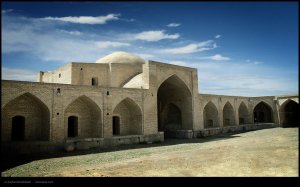
The Karaj’s Shah Abbasi Inn is a stone-brick building built in Shah Soleiman Safavid era between 1078 to 1109 SH. This building is located along the Silk Road and it is the only urban inn in Iran. This building infrastructure has been built by stone and its walls built of brick and mortar.
Dovecotes
Dovecotes were built as a place to collect the pigeons and other bird manure for use in agriculture. The pigeons manure had greatly used in the leather industry and gunpowder fabrication. Meybod dovecote tower is one of the historical monuments of Qajar era that has been built cylindrical. The tower is covered with hexagonal crenate dome and Qatar Bandi, stalactites in a straight line between the ceiling and walls of a room, of brick and plaster ornaments to prevent from entering snakes the tower.
Darvazeh Arg, Arg’s Gate
Darvaze arg, one of the Semnan architectural masterpieces, is related to Bahman Mirza Bahaodole reign, son of Fath Ali Shah Qajar, and according to its inscription, it was built during the reign of Nasereddin Shah Qajar and the reign of Anushirvan Mirza, the ruler of Semnan, Damghan, Shahrood and Bastam in 1302 AH. Current Darvazeh Arg, was the northern gate of Arg state in old Semnan of which nothing remained now.
Imam Khomeini’s house
Imam Khomeini’s house, the first supreme leader of Islamic Republic of Iran, is one of the important buildings of Qom that enjoys the special political and social background and has been best known due to being located in Yakhchal Qazi district. This building is one of the monuments at the early 14 century SH and was the last residential house of Imam Khomeini in the period of his living in this city.
Zanjan Rakhtshooy Khaneh
Zanjan Rakhtshooy Khaneh edifice was built by two brothers whose name were Mashhadi Akbar (architect) and Mashhadi Ismaeil (the builder) by the architecture method of the late Qajar era and the early Pahlavi era with the order of municipal manager, Ali Akbar Tofiqi in 1307 SH. No other building has been identified by the same usage in the other regions of this city. The most significant reason to build this building was creating an appropriate, enclosed and safe place to wash the clothes and dishes by women.
Bushehr Historical Area
The Bushehr Historical area is located in the northern part of a triangle-shaped peninsula “in the triangle vertex”, which has a dent in the Persian Gulf consists of four neighborhoods as “Dehdashti”, “Shahabadi”, “Kuti”, “Behbahani” and it is highly known for these neighborhoods according to ethnicities who live there. Bushehr historical areas like other historical cities contain gates, towers, bazaar, cistern, bathroom, mosque, governmental citadel, square etc. it also contains 1,000 houses that are the physical elements of constituting an Iranian-Islamic town.
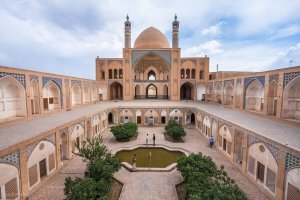 Agha Bozorg Mosque and School
Agha Bozorg Mosque and School
Agha Bozorg Mosque and School building is one of the most magnificent and beautiful mosques of Qajar era in Iran established by Haj Mohammad Taqi Khanban invest for prayer and discussion of his son-in-law, Mullah Mahdi Naraqi II known as Agha Bozorg, during 1250 to 1260 AH.
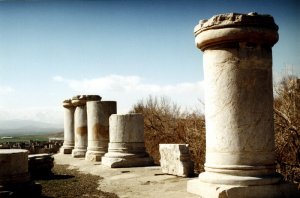 Anahita Temple
Anahita Temple
Anahita temple, the second glorious stone building after Persepolis in Iran, has been constructed on a natural hill by using the platform method. According to the ancient Iranians’ belief, Anahita was the water goddess, guardian angel of fountains and rain and also a symbol of fertility, love and friendship. Temple building has been divided into three Achaemenid, Parthian and Sassanid eras, and the other theories linked this building to an unfinished palace of Khosrow II in the late Sassanid era.
Chak Chak
Chak Chak is one of the most important shrines of the Zoroastrians in the mountain enjoyed a special reputation and many Zoroastrians come and pray in this place from 24 June for four days every year. Mehregan festival is held at this place every year. According to legends, this place has been the heaven of the daughter of Yazdgerd, a Sassanid king, Nik Bano, from the Muslims.
Vali Castle
Vali Castle is one of the most significant historical buildings related to the Qajar era in Ilam, which was built by Gholamreza Khan Vali order on the Choqamirak hill in 1326 AH. In fact, this building was used by a warden in summer.
Rudkhan Castle
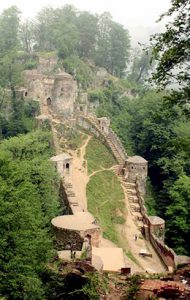
Rudkhan Castle (Ghale Roodkhan)| Fuman-Gilan
Rudkhan Castle or Hesami castle, is a historical castle with the height of 665 to 715 m above the sea level is located beside a river with the same name. Some historians considered the building time of the castle the Sasanian period coincided with the Arab invasion of Iran. The castle was rebuilt in the Seljuk period and has been one of the bases of Ismailis campaign.

